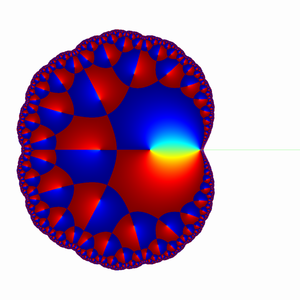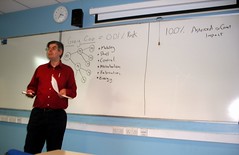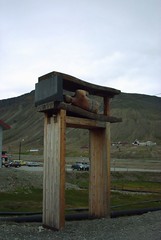March 30, 2009
A *really* green and sustainable humanity
 While posting in a debate (in Swedish) on Skiften about ecology, I started to wonder how sustainable one could make humanity.
While posting in a debate (in Swedish) on Skiften about ecology, I started to wonder how sustainable one could make humanity.
Obviously, one could just kill all people and hence reach "sustainability". Except that it would be deeply immoral and would deprive the Earth of any ability to protect itself from cosmic threats. Conversely, one could go for Blish and Knight's A Torrent of Faces and reshape the biosphere to just serve human needs; this would likely sustain a very big population, but few people today would be willing to give up the natural biosphere just for the delight of more company. Most people would clearly aim somewhere between these extremes, and since they are both worse than today we can be confident that there is at least one optimum.
Except that it is a fallacy to think that the only variable is the number of people. Clearly our technological level has an effect: Matt Ridley estimates that we would need 85 Earths to feed 6 billion hunter-gatherers, and 82% (rather than current 38%) of the world's land area for cultivation if we were using 1950's organic farming. Most modern technology is much more efficient than traditional forms (it just pays the price in the form of specialization). It is pretty plausible that we could grow food in an even more intensive way, say by using algal farms, hydroponics and aquaponics. This would avoid inefficient and area-demanding cattle and cereals and use lower trophic level nutrients more efficiently than as animal feeds. As food printing becomes better we might find algae much more useful in the kitchen than meat.
Another angle is of course to make humans consume less resources. Just as technology is changeable, so is human biology and psychology (with the right tools). I'm exploring the ethics of making people smaller in an upcoming paper. Since nutrient demands scale with mass and mass scales with length, just making people grow shorter will reduce the amount of food and other resources they need. Similarly we could conceivably modify ourselves to want less, or be more willing to go with the group. However, as sustainability goes this is no guarantee. It seems hard to reduce resource needs by orders of magnitude - as long as we stay human.
Postbiological and green
My favourite long-term solution is simply to aim for not just a post-industrial civilization but a post-biological one. We can currently roughly foresee how we could go about it. We would fixate our brains (presumably when near biological death), scan them in detail, reconstruct the functional structure and recreate it as software. The successor version would then go on living in virtual reality, with occasional visits to the physical world using a robot, android or just remote controlled human body.
How efficient could a postbiological civilization be? The current IBM roadrunner does 376 million calculations per watts. If we take my mid-range estimates of computing needs, 10^22 to 10^25 FLOPS, then a single emulation would need 10^13 to 10^16 watts. The total insolation of Earth is about 10^17 watts, so this won't do - there would be space for just a few minds on the entire planet. But current research on zettaflops computing suggest we can do much better. A DARPA exascale study suggests we can do 10^12 flops per watt, which means "just" a dozen Hoover dams per mind. Quantum dot cellular automata could give 10^19 flops per watt, putting the energy needs at 200-2000 watts.
That is between 2 and 20 times the current wattage of a current human. However, we bio-humans get our energy through the inefficient method of having plants collect sunshine (at about 3%) efficiency, then we either harvest them and eat a small part of them (expending a lot of agricultural energy) or have animals eat them (at a few percent efficiency) and finally we eat the result, again with a few percent efficiency. A brain emulation of this type would just need a few square meters of solar panels (plus night-time energy storage). In terms of area and energy required, these postbiological humans would have far smaller material requirements than we do. They could also run slower to save energy.
The quantum dot computer mentioned above is not the most effective computer imaginable. Using reversible computation there could in principle be calculations done at no energy dissipation. Unfortunately it would still be needed for error correction and interacting with the real world. A conservative bound would be assuming one irreversible operation every millisecond at every synapse, which leads to 10^17 operations and an energy dissipation of 3*10^-6 watts per degree - colder computers are more efficient. Using just liquid nitrogen (77 Kelvin) the energy requirements of a mind would be on the order of 0.0002 watts, 20% of an optical disc player laser. Even adding in the costs of cooling and manufacturing the hardware, it seems likely that this kind of postbiological human would be extremely resource efficient.
 How much matter would go into this system? Using the quantum dots again, each gate would be on the order of a nanometer. Each floating point operation would require about 20,000 gates. These gates would be re-used every 0.1 millisecond timestep, so a full 10^25 flop emulation would need a volume of 0.02 cubic meters. This does not take the rest of the infrastructure into account. Let's scale it up to one cubic meter. 6.7 billion people would then require the same volume, or a cube with side 1885 meters if bunched together into the ultimate datacenter. That is unlikely to work if the energy use is on the orders of many watts per person, since cooling would be hard (not to mention the vulnerability of having everybody in the same spot). A more likely solution would be smaller centres distributed close to energy sources: a single hydroelectric dam would supply several million people with energy, a square kilometre of 20% efficiency solar panels would supply 150,000-1.5 million people. A 100x100 kilometre area would be enough to run all of posthumanity. And if the reversible computing works, the energy collection infrastructure could be 10,000 times smaller.
How much matter would go into this system? Using the quantum dots again, each gate would be on the order of a nanometer. Each floating point operation would require about 20,000 gates. These gates would be re-used every 0.1 millisecond timestep, so a full 10^25 flop emulation would need a volume of 0.02 cubic meters. This does not take the rest of the infrastructure into account. Let's scale it up to one cubic meter. 6.7 billion people would then require the same volume, or a cube with side 1885 meters if bunched together into the ultimate datacenter. That is unlikely to work if the energy use is on the orders of many watts per person, since cooling would be hard (not to mention the vulnerability of having everybody in the same spot). A more likely solution would be smaller centres distributed close to energy sources: a single hydroelectric dam would supply several million people with energy, a square kilometre of 20% efficiency solar panels would supply 150,000-1.5 million people. A 100x100 kilometre area would be enough to run all of posthumanity. And if the reversible computing works, the energy collection infrastructure could be 10,000 times smaller.
Maybe the most sustainable thing we could do would be to aim at a future ensconced in cold datacenters under the subtropical deserts of Earth. Humanity would largely look like a forest of quiet semiconductor trees. We would indeed have become plants.
The total investments needed to get to posthuman planthood are enormous by today's standards, far beyond anything envisioned in the current climate debate. But we have already built enormously expensive systems piece by piece: the internet has more than a billion computers, and would likely be worth at least a few trillion dollars just in terms of hardware. Better computers, more efficient energy collection and cooling, better neural simulations and better robotics have numerous desirable uses beside turning us postbiological, and will hence be developed. Once emulation becomes possible, there are strong economic forces at work that would likely increase the total amount of wealth enormously, enabling the development of very effective technology rapidly (but also, risk a population explosion of emulations - there is much to be said for space colonization at this stage, both as a way of reducing resource constraints and reducing risks from the turbulent transition).
I personally think that this sketch of a post-biological vegetable humanity is one of the most positive possibilities for our future. I think, once the technology is around, it will attract people voluntarily (after all, it gives the chance for immortality, any conceivable lifestyle *and* is green). It is sustainable, since it would use a minuscule amount of resources, energy and area to keep mankind running and would not need great material flows. Just running on renewable energy it could easily last until the sun starts to act up. It is also able to protect itself and the environment from unforeseen threats: going virtual does not mean we completely abandon the physical world (we would be keeping telepresence bodies around for tourism, repair and science - as well as a few small colonies of holdouts of Homo sapiens just in case).
Real sustainability
 Thinking about sustainability means thinking long-term. Sustainability solutions need to work for enormous timescales (most "sustainability" discussed today is about getting out of our current predicament - laudable and necessary, but not a long-term solution). I think a postbiological ecological niche is very stable, since it has very simple physical requirements (energy, nitrogen, computer hardware and the tools to make it) regardless of what is going on culturally inside it. While that might not prevent future generations from reaching the conclusion that it would be a good idea to cover the Earth with photovoltaics or blow it up to build a Dyson shell from the remnants, that is their choice. We cannot really control the moral decisions of future generations - especially since they might actually know more than we do.
Thinking about sustainability means thinking long-term. Sustainability solutions need to work for enormous timescales (most "sustainability" discussed today is about getting out of our current predicament - laudable and necessary, but not a long-term solution). I think a postbiological ecological niche is very stable, since it has very simple physical requirements (energy, nitrogen, computer hardware and the tools to make it) regardless of what is going on culturally inside it. While that might not prevent future generations from reaching the conclusion that it would be a good idea to cover the Earth with photovoltaics or blow it up to build a Dyson shell from the remnants, that is their choice. We cannot really control the moral decisions of future generations - especially since they might actually know more than we do.
I don't think romanticised small agrarian communities (or hunter-gatherers) are stable over megayears - as the climate and culture changes, sooner or later someone will get exponential ideas and re-run industrialization. Or they will be wiped out the next time a supervolcano erupts. Similarly any kind of civilization of biological humans will be subjected to environmental challenges (remember, we are running out of interglacial! This is a good reason to save oil) and genetic drift. It would need to maintain itself against the environment, necessitating reasonably big material and energy flows (even if they are efficient) just to have stockpiles. It would need cultural constraints to keep from veering into dangerous areas, degenerating or going posthuman one way or another - and these constraints would need to be upheld globally indefinitely. Some form of Singleton - something with power over humanity's actions that could sustain its power indefinitely - would likely be needed. We do not know if singletons are possible, and I have strong intuitions that most possible singletons are very nasty (Orwell suggested one in 1984 - a stable worldwide tripartite dictatorship system).
To minimize ecological impact, we should be as efficient as possible and use as little material, energy and area resources as possible. To be sustainable the state must be resilient against disturbances and be able to persist indefinitely. To be human (in a broad sense), there must be room for individual life projects, diversity, pleasure and exploration. I think going postbiological is the only way we can achieve all this in the long term.
March 26, 2009
Doing the journalists' job for them
 The science behind the news stories is a wonderful little experiment. It takes an url of a BBC news story about a scientific finding and tries to extract enough information from the text to determine which scientific paper it is about.
The science behind the news stories is a wonderful little experiment. It takes an url of a BBC news story about a scientific finding and tries to extract enough information from the text to determine which scientific paper it is about.
This is an annoying problem for bloggers and scientists: there are many news stories based on science that might merit a proper response based on their source rather than the often limited or distorted reporting - but the stories almost never state which study led to the story. Journalists and/or press release writers seem to assume news consumers are unable and uninterested in going to the sources. While in a newspaper space might be at a premium and even a tinyurl might be too large, on the web there is simply no excuse for not linking or naming the article.
I hope Adam Bernard's little project grows, so we can use it to mine not just BBC but the other news sources. Of course, they could just start adding urls. But it seems more likely that we, the readers, will have to become computer-supported sleuths instead to circumvent the limitations of the news business. And science may just be the first step - there are probably many other aspects of news that could be enhanced if we mined it.
March 24, 2009
Mercator Mandelbrot
Thanks to an idea used by David Madore as a map for his Mandelbrot set zoom, I have been happily rendering Mercator Mandelbrot Maps during free time this weekend.
The idea is to focus on a point in or near the Mandelbrot set, and create an image where one direction is the logarithm of the distance and the other one the angle. The result is very much like the astro-ph/031571 map and theXKCD cartoon versions. This map projection is conformal, so it does not distort local angles, and objects are usually recognizable on all scales.
The leftmost edge corresponds to a scale of ~10-15, at which point Matlab's numeric resolution starts to become too crude to allow deeper zooms. I'm looking into using higher accuracy routines to calculate truly long maps. At the rightmost edge is the main part of the set, sometimes amusingly warped
Finding a good zoom location is equivalent to finding a place on the set where there is the right amount of detail on many different scales. Tip edges like c=i and Misiurewicz points produce repeating patterns. A nice heuristic for a "baroque style" picture is to go for the mini-Mandelbrots, zoom in close to them, find another mini, zoom in there and so on. This way the sets become surrounded by embedded Julia sets, and each new mini-Mandelbrot contributes another set, adding variation to the picture.
I first used the continuous potential method to color the image, but it makes filaments hard to see. I found the distance estimator method much better, since it really shows the gorgeous complexity. This way it is usually possible to trace the filament leading to the deepest part of the picture all the way out to the main set.
March 20, 2009
"http://tinyurl.com/9uxdwc"
 Occasionally, like any social animal, I feel a desire to make protest art. So here is my little contribution named: "http://tinyurl.com/9uxdwc". (Of course, living in Lewis Carroll's Oxford, I do not call the artwork that, and the name of it has another name.)
Occasionally, like any social animal, I feel a desire to make protest art. So here is my little contribution named: "http://tinyurl.com/9uxdwc". (Of course, living in Lewis Carroll's Oxford, I do not call the artwork that, and the name of it has another name.)
It is a Processing applet that renders a picture using the sites on the Danish net blacklist that was leaked to wikileaks. Which then became censored in Australia, and AU links to the page were threatened with $10,000 fines. We'll see if this artwork can escape that fate.
The basic problem, as Wikileaks points out, is "the first rule of censorship is that you cannot talk about censorship". The fundamental problem with all net blacklists is that they are nearly impossible to check legally for accuracy, since 1) you are not supposed to be able to access what is on them, and 2) they are not supposed to be revealed, since that would tell people where bad things are. And this usually means criticisms of their actual contents also get censored, and so ad nauseam.
The sensible thing to do, insofar blacklists are to be used at all, is to have a trusted third party check it for accuracy and handle removal requests. But right now most national infrastructures for blacklisting are extremely crude, and lack both transparency and accountability. For blacklisting to be anything more than a tool for limiting freedom it needs those two traits.
March 19, 2009
Some posthuman beliefs
 Material Beliefs interviewed me a while ago about the posthuman, and the film is now on-line (and will eventually appear on a DVD). Not sure how much sense I make, but it was fun. I was gesticulating wildly with my teacup outside the frame.
Material Beliefs interviewed me a while ago about the posthuman, and the film is now on-line (and will eventually appear on a DVD). Not sure how much sense I make, but it was fun. I was gesticulating wildly with my teacup outside the frame.
I think the key idea of the posthuman in the sense I use it is simply this: we can change the human condition *a lot* in the near future. Not through some gradual natural change, and not necessarily through a deliberate decision to go this or that way. That forces us to take stock of the current human condition and seriously consider what we think we ought to keep and what could go. It also makes vivid the contingency of our current state: it is the relativisation not just of our culture, but our species.
The things that still make sense in the light of such relativisation are going to be very robust and important principles. But most of life is about things that could be different - we could have different societal arrangements, different structures of life, different motivational systems, different arts and entertainment etc. The big principles may set the boundaries and aims for whole societies and civilizations, but the stuff that makes them worthwhile to live in will be pretty arbitrary, cultural and mercurial. We need the universality of human rights (or, rather, person rights) and structures like open democratic societies to flourish, but the kinds of flourishing people are doing are going to be manifold, unexpected and often controversial.
March 14, 2009
Happy pi day!
I wanted to make a picture based on pi. Since I have been playing around with fractals recently I though I should try making one based on pi. After all, there are many beautiful formulas that generate pi, and some ought to be possible to turn into fractals.
One of the earliest and most impressive pi formulas is François Viète's formula:

Unfortunately the formula is a bit too nicely behaved to produce any fractals on its own. However, my first try to implement it was a mistake but it produced a neat fractal (with a bit of motion illusion):

In this case the recursion formula is zn+1 = zn sqrt(0.5 + 0.5*zn). In the above picture I plot the argument of the iterates. A nice hyperbolic tiling inside a brain-shaped fractal.
March 12, 2009
If we treated 100 people like you with Bacon sandwiches...
 2845 ways to spin the Risk | Understanding Uncertainty (via Bad Science). A very nice little demonstration of how risk can be spun/visualized/confused by how it is expressed.
2845 ways to spin the Risk | Understanding Uncertainty (via Bad Science). A very nice little demonstration of how risk can be spun/visualized/confused by how it is expressed.
The site is quite good. Even a cursory look finds several interesting articles and simulations. We need more education about risks and risk perception if we are to be able to actually live in a risk society. Since risk is one of the few values everybody can agree on in a post-ideological and pragmatic political mainstream it is very important to be able to be critical about it. (The reason people can agree on the importance of risk is of course, just like human dignity, that different people have different ideas of what it is but never expose them)
March 10, 2009
Ethical divergence
 Practical Ethics: Bad doctor, bad prosecutor or bad laws? - I blog about the current tragic affair about the arrested doctor at the Astrid Lindgren Children's Hospital. The problem is IMHO the divergence between medical practice and law, and I blame the politicians.
Practical Ethics: Bad doctor, bad prosecutor or bad laws? - I blog about the current tragic affair about the arrested doctor at the Astrid Lindgren Children's Hospital. The problem is IMHO the divergence between medical practice and law, and I blame the politicians.
In a wider sense the real problem is that there are so many areas of crucial importance in our society that are closed to the outside society that they run the risk of diverging seriously from legal or public ethical norms. Some may deliberately avoid contact, like the intelligence community. Others are isolated by technical complexity or social avoidance/closedness (like both medicine and much of the software world). Some might be isolated by a generational lack of understanding or shifting norms, such as the file sharing community. Maybe a natural effect of a more complex and rapidly changing society is that we end up with wildly divergent pockets that occasionally cause surprise or a legal stink when it becomes apparent what they have been doing.
March 07, 2009
Watching Watchmen
 I saw Watchmen tonight - I can even claim it was research, since I'm doing a small piece on the ethics of the novel. Some comments:
I saw Watchmen tonight - I can even claim it was research, since I'm doing a small piece on the ethics of the novel. Some comments:
- The worldbuilding was largely impeccable. Except for glaring details like the lack of smoking due to health censorship.
- Yet the parts where the movie really shines is when it deviates from the novel. There is much to be said for uncertainty and indeterminism, at least in an action story.
- The problem is that the rigid, interlocking clockwork structure of the novel disappears. This is of course because it is nearly impossible to transfer to film. The reflections, recurring symbols, interleaving etc. certainly can be done on film, but the sheer density would totally smother the story in this case. Unfortunately I think that without the structure much is lost: the structure of the film is like seeing the blurred outlines of a wettened blueprint that had once been precise.
- So the dilemma is that following the novel would make a boring, possibly unwatchable movie. Leaving the novel gives it life, but loses the core.
- I have always loved the portrait of Dr Manhattan's sense of time in the novel. He lives within Einstein's "block time" deterministic crystal of causality, seeing everything yet constrained by what he knows will be his future. No warm and fuzzy "love conquers all" or free will, just consistency. I think this is largely a correct view of the universe, except that everything is going on within a many-worlds multiverse rather than a single crystal.
- Unfortunately the confused "thermodynamic miracle" explanation for why to care for humans remain. As it stands, it is like being amazed of getting the particular poker hand one got out of all the possibilities - a trivial observation, and applicable to any macroscopic system, not just humans. A better take would be to recognize the enormous level of contingency of humans. Humans are highly specific structures with internal consistency and meaning, yet enormously variable and history-dependent. Most arrangements of quarks and leptons lack these properties.
- Using Philip Glass music for Dr Manhattan was perfect - timefree, alien and from the right era. While some of the background music is too clever and dominant (not always wrong; Rex Tremendae Majestatis had me grinning widely) this is exactly right.
- Not sure with the CG depiction of Dr Manhattan and his clockwork palace. On one hand they probably shouldn't look too real - the Dr isn't quite here, so to say - but sometimes it just looked like old computer graphics. Maintaining both the realism and the otherworldliness was a challenge I don't think succeeded.
- The big change in the plot actually makes sense. I can imagine a five year child telling the villain after he explained his original plan "But nobody will fall for that!" So he went back to the drawing board and came up with a much more plausible Big Bad, which also strengthens many otherwise weak plot threads.
- The computers were correctly 80's, except that I doubt Ozymandias would be using his mac in reverse mode. The biggest anachronism was probably the fingerprint detection on Night Owl's glasses.
- It is curious how dated the cold war threat feels today. I do not go to bed like I did in the 80's thinking that the missiles could already be in the air. Yet the stockpiles largely remain, the systems are likely as crufty as before, mistakes happen and the stabilization due to the MAD doctrine might be dissolving in a polycentric world. It is exhilarating to consider that a fundamental, almost defining, feature of the world as we experience it can dissolve into history over less than a generation. And people think we transhumanists are absurdly optimistic about how different the future can be.
Was it an evening well spent? Yes. What, in life, does not deserve celebrating?
March 04, 2009
Factoids
 FuturePundit points out that Over Half Of Humanity Use Cell Phones. A cheerful fact, but also pretty surprising to many people.
FuturePundit points out that Over Half Of Humanity Use Cell Phones. A cheerful fact, but also pretty surprising to many people.
I have heard people make the claim "half of mankind has yet to make a phone call" very recently (example from 2001) - it sounds sobering and truthful, but has probably been untrue for more than a decade. There are likely a lot of similar factoids out there. When it comes to the rapid improvements or changes of how humans live there is a sizeable cognitive lag even among people claiming to monitor the world situation. I wonder how many people have really understood that we are now a predominantly urban species? Looking at how India (and many other countries) is presented in Swedish television the lag also becomes apparent: in the eyes of most of the journalists it is a poor country and should be depicted as such. That the old state (homogeneously poor with a tiny elite) is very different from the current state doesn't fit the story they tend to fall into - since that story biases how they tend to interpret what they see. And they learned it from previous media, and so on. The lag due to biased narratives distorts our worldview. There are plenty of people out there who thinks the population explosion is still in swing (yes, we are getting more people but the rate is slowing. Iran is now at replacement fertility) or that increased standards of living necessarily require a proportional amount of resources - claims which have been untrue for decades by now.
The time it takes for a fundamental shift in the human situation to percolate is frighteningly slow. Which explains why some bad decisions are made, and suggests that we are likely wrong about many presently held "truths" about the state of mankind. The information is out there, but it diffuses slowly.




